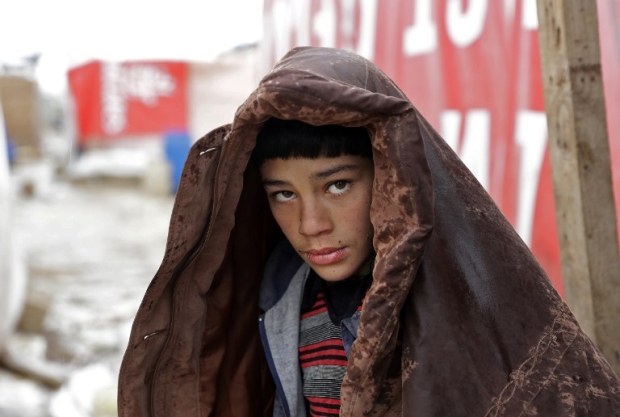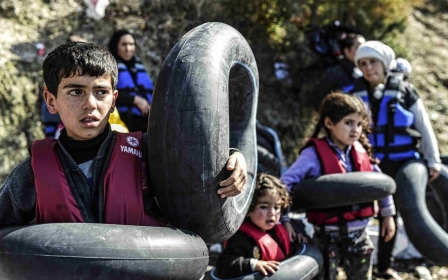How to defuse the child refugee time bomb lit in Syria

In the age of innocence of their revolution, Syrians observed with hope and trepidation every international meeting convening to discuss their fate. “Friends of Syria” and co-sponsors of peace talks, it was initially expected, would at least have their own best interests at heart and put an end to the Assad regime’s merciless brutality, if only to stop Syrians from seeking refuge beyond their crowded borders. That was the theory.
This week’s Brussels conference will probably not deviate much from previous exercises in futility
In practice, international policy turned out to be one of irresponsible laissez-faire for Bashar al-Assad and his backers, on a political, military and economic level with disastrous consequences for countries near and far. These six years of deliberate inaction have borne fruit, resulting in more than half a million Syrians dead, millions maimed and wounded, and well over half the population displaced.
The magnitude of challenges facing Syrians today beggars belief, and yet this week’s Brussels conference will probably not deviate much from previous exercises in futility. If anything, regional and global powerhouses are distancing themselves ever further from notions of political transitions, let alone of accountability and justice for crimes against humanity.
Dealing with the Islamic State while letting Assad be Assad is the bizarre new modus operandi, under the guise of damage control; this allows an emboldened regime, protected by Russia, to escalate its murderous campaign, even with chemical weapons supposedly confiscated under the 2013 deal, on the very day the Brussels meeting appeals again for peace talks.
This seventh year of war portends adjustments to prevailing declared positions: ideally, Syrian dust - and skeletons - would be swept under the proverbial rug, safe zones yet to be defined or designated would magically absorb millions of endangered Syrians, rubble in select areas would make way for new and improved crony capitalist infrastructure, and hurried, basic social dwellings would house forcibly displaced people.
After premature self-congratulatory speeches, the Syria problem would be declared - mostly - fixed.
In other words, madness.
First, do nothing
Depoliticising the conflict, emphasising the danger of the Islamic State while downplaying that of the far more lethal ongoing Assad regime killing machine, sanctioning Iran and Russia’s sponsorship of demographic change and forced population displacement, and considering reconstruction in these circumstances is not only political cowardice of the highest order, but above all an unworkable and self-defeating strategy.
The vast majority of these children are now illiterate, having received no formal education for years
Moreover, it will do practically nothing to relieve the issue of utmost concern to our beacons of freedom and democracy: the problem of refugees. Overwhelmed aid agencies have sounded increasingly strident alarms about present conditions, but assessments of a frightening near future don’t seem to have sunk in. Without immediate and concerted action, the refugee problem will intensify, not recede.
There are well over six million Syrian refugees abroad, and at least seven million displaced inside their own country. A very large number of these current 13-plus million refugees are children.
The vast majority of these children are now illiterate, having received no formal education for years. Even those who had initial basic literacy have mostly forgotten the little they knew, and there is neither the will nor the infrastructure to change this so far.
The vast majority of these children are forced to beg or to work in unacceptable conditions, or are idle and roaming around aimlessly, unsupervised and unprotected.
The vast majority of these children are in urgent need of professional help, of physical and mental health care, of structure and purpose, and of formal education. These children are bored, frustrated, tired, angry, traumatised, depressed, and abandoned to their fate.
Mathematical certainty
As these children turn into teens and young adults in physical and psychological isolation, they will find only a couple of outlets to unleash their frustrations: sex, and religion. Syrians already had a high population growth rate, and forced exile and dispossession has triggered a drastic increase in underage marriages.
These children are bored, frustrated, tired, angry, traumatised, depressed, and abandoned to their fate
If this trend is not reversed, today’s illiterate children will marry illiterate children like them, together procreating their own children who will be illiterate like their young parents, with only rigid and charged religious teachings to impart some meaning to their miserable lives.
This explosive mixture is not a worst-case scenario: it is a mathematical certainty.
So as so-called realists begin to sketch a map of a “useful” Syria to be rebuilt and of a “useless” one to be allowed to die, and as they begin vague plans for “safe zones” (which, after years of claims that no-fly-zones and humanitarian corridors were impossible, may well be politically correct terms for de facto ghettos), what is in store for these millions of refugees?
Will they be willing to “return” to such misery, or will they be forcibly transferred to these zones in yet more green buses, possibly unleashing a desperate massive new exodus across the Mediterranean?
The alternative to doing nothing
There are more questions than answers as the time bomb ticks, but some actions need not wait for a comprehensive solution to the Syrian tragedy. There is already much the international donor community should have done and can still do, if only to confront the threats facing refugee children.
It is possible for donor governments to rapidly erect simple and cheap on-site schools connected to water, electricity and internet
It is possible for every single government with an international aid programme to commit to undertake in full the cost and the logistics of educating an agreed number of children in specific areas, sketching this map before all others in collaboration with aid agencies.
It is possible for each of these governments to rapidly erect simple and cheap on-site schools connected to water, electricity and internet. It is possible to provide books, cheap computers and school accessories for these children. It is possible for education experts and Syrian civil society specialists to develop a basic curriculum - for all Syrian children - that can make up for lost time and cover new ground as they learn to write, to count, to think and to programme. It is possible to send teams of qualified instructors to train educated Syrians to become teachers themselves.
Political considerations and bureaucratic red tape are often used to justify inaction, but donor countries have both the interest and the capacity to make the possible happen. Rescuing an otherwise lost generation is not just a magnanimous action for Syrians’ sake, but an initial contribution to defusing an explosive refugee problem.
There has always been an alternative to laissez-faire; it’s as simple as ABC.
- Rime Allaf is a Syrian-born writer and political analyst. She was an Associate Fellow at Chatham House from 2004 to 2012, in the Middle East and North Africa Programme. She has published numerous analyses and articles on the region, with Syria being the focus of her area of expertise, and continues to write, speak and advise on Syrian affairs. She is on the Board of Directors of The Day After, a renowned Syrian-led civil society organisation working to support a democratic transition in Syria, with grants from several Western institutes and governments. She is also on the Board of Directors of the Syrian Economic Forum, a think tank working on building a strong economy to support a free, pluralistic and independent state.
The views expressed in this article belong to the author and do not necessarily reflect the editorial policy of Middle East Eye.
Photo: Young Syrian refugee children line up for food as Syrians break their fasting in June 2015 in Akcakale, in Sanliurfa province, during the holy month of Ramadan (AFP)
New MEE newsletter: Jerusalem Dispatch
Sign up to get the latest insights and analysis on Israel-Palestine, alongside Turkey Unpacked and other MEE newsletters
Middle East Eye delivers independent and unrivalled coverage and analysis of the Middle East, North Africa and beyond. To learn more about republishing this content and the associated fees, please fill out this form. More about MEE can be found here.







